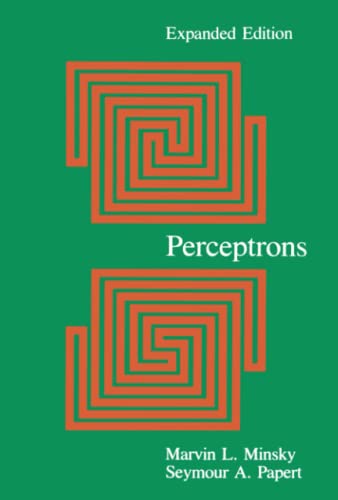
Synopsis
Perceptrons - the first systematic study of parallelism in computation - has remained a classical work on threshold automata networks for nearly two decades. It marked a historical turn in artificial intelligence, and it is required reading for anyone who wants to understand the connectionist counterrevolution that is going on today. Artificial-intelligence research, which for a time concentrated on the programming of ton Neumann computers, is swinging back to the idea that intelligence might emerge from the activity of networks of neuronlike entities. Minsky and Papert's book was the first example of a mathematical analysis carried far enough to show the exact limitations of a class of computing machines that could seriously be considered as models of the brain. Now the new developments in mathematical tools, the recent interest of physicists in the theory of disordered matter, the new insights into and psychological models of how the brain works, and the evolution of fast computers that can simulate networks of automata have given Perceptrons new importance.Witnessing the swing of the intellectual pendulum, Minsky and Papert have added a new chapter in which they discuss the current state of parallel computers, review developments since the appearance of the 1972 edition, and identify new research directions related to connectionism. They note a central theoretical challenge facing connectionism: the challenge to reach a deeper understanding of how "objects" or "agents" with individuality can emerge in a network. Progress in this area would link connectionism with what the authors have called "society theories of mind." Marvin L. Minsky is Donner Professor of Science in M.I.T.'s Electrical Engineering and Computer Science Department. Seymour A. Papert is Professor of Media Technology at M.I.T. .
Les informations fournies dans la section « Synopsis » peuvent faire référence à une autre édition de ce titre.
À propos des auteurs
The late Seymour A. Papert was a Professor in MIT's AI Lab (1960–1980s) and MIT's Media Lab (1985–2000) and the author of Mindstorms: Children, Computers, and Powerful Ideas.
Les informations fournies dans la section « A propos du livre » peuvent faire référence à une autre édition de ce titre.
Autres éditions populaires du même titre
Résultats de recherche pour Perceptrons, expanded edition: An Introduction to Computatio...
Perceptrons : An Introduction to Computational Geometry
Vendeur : Better World Books: West, Reno, NV, Etats-Unis
Etat : Good. Exp Sub. Used book that is in clean, average condition without any missing pages. N° de réf. du vendeur 4310224-6
Acheter D'occasion
Quantité disponible : 1 disponible(s)
Perceptrons, Expanded Edition An Introduction to Computational Geometry
Vendeur : Skoob-ebooks, Pontiac, QC, Canada
Softcover. Etat : Good. Average wear. The pages are clean with no highlighting or writing detected. Cover has some corners that are scuffed/curled. 30-day returns. Shipments destined outside Canada may be subject to duties in the country where the customer resides. ; 6 X 0.71 X 8.9 inches; 312 pages; R5 791k/786k s3. N° de réf. du vendeur 8734
Acheter D'occasion
Quantité disponible : 1 disponible(s)
Perceptrons: An Introduction to Computational Geometry, Expanded Edition
Vendeur : Wonder Book, Frederick, MD, Etats-Unis
Etat : As New. Like New condition. A near perfect copy that may have very minor cosmetic defects. N° de réf. du vendeur M10A-04206
Acheter D'occasion
Quantité disponible : 1 disponible(s)
Perceptrons: An Introduction to Computational Geometry, Expanded Edition
Vendeur : upickbook, Daly City, CA, Etats-Unis
paperback. Etat : New. N° de réf. du vendeur mon0000234666
Acheter neuf
Quantité disponible : 1 disponible(s)
Perceptrons: An Introduction to Computational Geometry, Expanded Edition
Vendeur : Book House in Dinkytown, IOBA, Minneapolis, MN, Etats-Unis
paperback. Etat : Very Good. 1988 expanded second edition of this foundational text in artificial intelligence. Spine is uncreased, binding tight and sturdy. Light shelfwear to wraps. Interior is free of previous owner markings. Ships same or next day from Dinkytown, Minneapolis, Minnesota. N° de réf. du vendeur 329158
Acheter D'occasion
Quantité disponible : 1 disponible(s)
Perceptrons An Intro to Computational Geometry Exp Ed
Vendeur : Revaluation Books, Exeter, Royaume-Uni
Paperback. Etat : Brand New. exp sub edition. 312 pages. 9.25x6.00x0.75 inches. In Stock. N° de réf. du vendeur zk0262631113
Acheter neuf
Quantité disponible : 1 disponible(s)
Perceptrons: An Introduction to Computational Geometry, Expanded Edition
Vendeur : BennettBooksLtd, San Diego, NV, Etats-Unis
Paperback. Etat : New. In shrink wrap. Looks like an interesting title! N° de réf. du vendeur Q-0262631113
Acheter neuf
Quantité disponible : 1 disponible(s)

